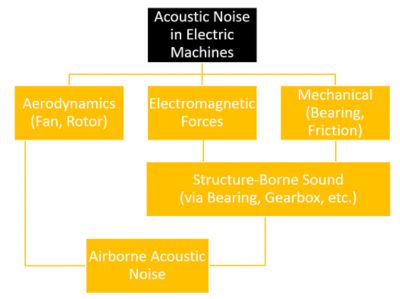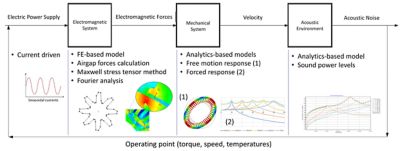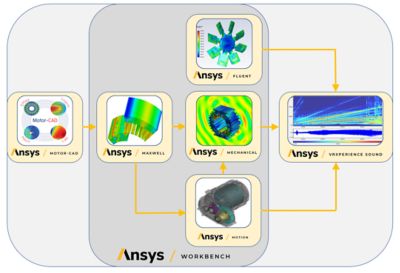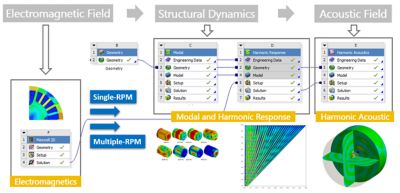ANSYS BLOG
May 31, 2022
How Simulation Helps You Overcome Electric Machine NVH Challenges
Noise, vibration, and harshness (NVH) is an important design criterion for many applications where electric machines are involved — from medical devices, to electrified mobility and household appliances. An elevated level of vibration reduces the lifetime of electric machines, while loud sounds generate noise pollution and have adverse effects on health and comfort. Also, in critical applications such as military devices, NVH creates a vibroacoustic signature. It’s no wonder that several national and international standards and certifications require limiting the vibration and audible noise generated by devices to a certain acceptable level.

Multi-component systems with embedded electric machines such as electric vehicles, home appliances, and medical devices are complex systems. Due to this complexity and the nonlinear coupled physics governing the magnetic and structural behavior of these systems, the level of acoustic noise in applications is not easy to predict without proper modeling and simulation. Relying on a pure experimental approach in design and optimizations of quiet electric machines increases the cost and time for design modifications significantly. In many cases, NVH issues are identified during prototype testing, which is the last stage of the design cycle. Making design changes during this stage proves to be expensive and delays the production cycle. This is where simulation comes into play. Simulation can help in the accurate prediction of vibration and acoustic noise at the beginning of the design cycle, so is key to reducing production cost and time to market.
What Causes Acoustic Noise in Electric Machines?
“Electric machine” is a general term for machines such as electric motors and electric generators. Their primary function is to convert electricity to mechanical power or vice versa. During the function of these complex machines, there are various sources causing vibration and acoustic noise in them such as imperfect mechanical assembly, rotor and fan aerodynamics, and electromagnetic forces. Among them, electromagnetic forces, especially radial forces, are the major cause for unpleasant sounds generated from electric machines. There are two components in electromagnetic forces: radial force and tangential force. Radial force does not contribute to energy conversion while generating vibrations. On the other hand, tangential force contributes to energy conversion via average electromagnetic torque and to noise and vibration through torque pulsation.
Aerodynamic noise directly propagates to the surrounding space while the force and vibration transfer through mechanical structures and then radiate to the surrounding space via surface displacement.

Fig. 2. Acoustic noise sources in electrical machines.
Why is it Challenging to Predict Vibration and Acoustic Noise in Electric Machines?
Prediction of vibration and acoustic noise generated by electric machines is an important but challenging task due to different physical domains and complex interactions among these domains. Electromagnetics, thermodynamics, and vibro-acoustic analyses are required in a coupled fashion for a precise prediction of acoustic noise generated by electric machines. This becomes even more challenging when you consider electric machines as an integrated part of a larger system like an electric powertrain. Interaction between the electric machine and other parts of the system — like a gearbox and mounting hardware — affect the vibration and acoustic noise significantly and should be considered in the simulation. Therefore, to accurately predict the acoustic noise there are four essential elements of importance,
- Need for a high-fidelity simulation solution to account for all the physics involved.
- A platform to couple all the different physics elements.
- Ability to parameterize and optimize machine design parameters for each of the physics involved.
- High performance computing (HPC) capability to accelerate the simulation.
A detailed NVH analysis is required to fine tune the design for optimized NVH performance, but it may not be the best solution for the concept design and sizing stages where designers need to select proper topology among many choices and perform iterative trade-off design studies. A quick NVH check in the design and sizing process can eliminate high noise cases and can save a lot of time by avoiding a need for substantial changes during the optimization process. The quick NVH workflow should still include major physics with more time efficient models.
Leveraging Simulation to Meet NVH Requirements in Electrical Machines
Ansys offers an end-to-end NVH solution for electric machines. The solution includes a fast NVH workflow and a high-fidelity NVH workflow for calculating acoustic noise of electromagnetic and mechanical origins. Aerodynamic origin acoustic noise can also be calculated using Ansys Fluent.
Fast NVH Workflow
A fast NVH workflow is developed for the concept design stage where a quick comparison of noise level for different motor designs/topologies is needed, and only takes a few minutes to predict the noise over a full speed sweep. It can identify the cause of motor noise early on and help make relevant design changes in trade-off with other motor performance targets, allowing the NVH, thermal, and electromagnetic behavior to be investigated at the same time.
The workflow shown in figure 3 is completely integrated into Ansys Motor-CAD. It begins with a current-driven, finite-element-based electromagnetic analysis where airgap forces are calculated using the Maxwell stress tensor method. These forces can be plotted in various forms along with their time and frequency domain harmonics. Then, these forces are used by an analytical mechanical model to calculate free motion and forced responses. Surface velocity is then transferred to an analytical acoustic model to compute the sound power levels. This workflow can be run for different values of torque, speed, and temperature.
The NVH workflow in Ansys Motor-CAD provides designers with various representations of force, displacement, and acoustic power as seen in Fig. 4. In addition to concept comparisons, the speed of the workflow allows for rapid design iteration to investigate many different options to improve NVH performance.

Fig. 3. Fast noise, vibration, and harshness workflow

Fig. 4. Various forms of noise, vibration, and harshness results visualization are available in Ansys Motor-CAD.
High-Fidelity is the Key
A high-fidelity NVH workflow requires coupled Multiphysics analysis using 2D and 3D finite element method (FEM). We want to take you through a true best-in-class multiphysics workflow from Ansys.

Fig. 5. High-fidelity noise, vibration, and harshness workflow
Looking at the complete workflow as shown in figure 5: First the best design candidate is chosen in Ansys Motor-CAD. Following that, a 2D or 3D Maxwell model can be generated automatically. Detailed magnetic analysis is performed in Ansys Maxwell to calculate electromagnetic forces inside the machine. Circuit-coupled transient analysis provides the user with the capability to consider carrier harmonics from power electronics converters.
Electromagnetic forces are automatically mapped to the mechanical model in Ansys Mechanical for vibroacoustic analysis. Details of electric motor structure such as bearing, housing, and mounting can significantly affect the vibrational behavior through a change in natural frequency and overall damping. This can be precisely modeled in Mechanical in both time and frequency domains. In the case of electric drivetrain, the mechanical origin vibration from gearbox, bearing, and auxiliary system can also be added using Ansys Motion. The acoustic module in Ansys mechanical calculates the acoustic power radiated from electric machine surface to surrounding.
Finally, computed acoustic noise can be sent to Ansys Sound for generating audible sound and extra postprocessing. In parallel, aeroacoustics noise can be calculated using Ansys Fluent and transferred to Ansys Sound to be combined with acoustic noise from mechanical and electromagnetic sources.
To bring all these elements together, Ansys offers the Workbench Platform to connect all physics and several HPC algorithms throughout the process to accelerate high-fidelity NVH computations. An example to give you a clear idea of how different physics are connected inside Ansys Workbench to perform NVH analysis is shown in figure 6.

Fig. 6. Different physics connect in Ansys Workbench to compute acoustic noise generated by an electric machine.
Ansys offers solutions for NVH simulation in electric machines from concept design to sound perception level. Multiphysics fast and high-fidelity workflows are provided to address the NVH analysis needs throughout the entire design and validation process. In addition, Ansys optiSLang can be used to optimize NVH performance over both fast and high-fidelity NVH workflows thanks to Ansys high-performance computing and cloud solutions.
To learn more abot the NVH workflow with real life examples, watch this on-demand webinar: Multiphysics Simulation for NVH Analysis of Electric Machines.
References
- R. M. Pindorya, et al., “An Analysis of Vibration and Acoustic Noise of BLDC Motor Drive”, DOI: 10.1109/PESGM.2018.8585750